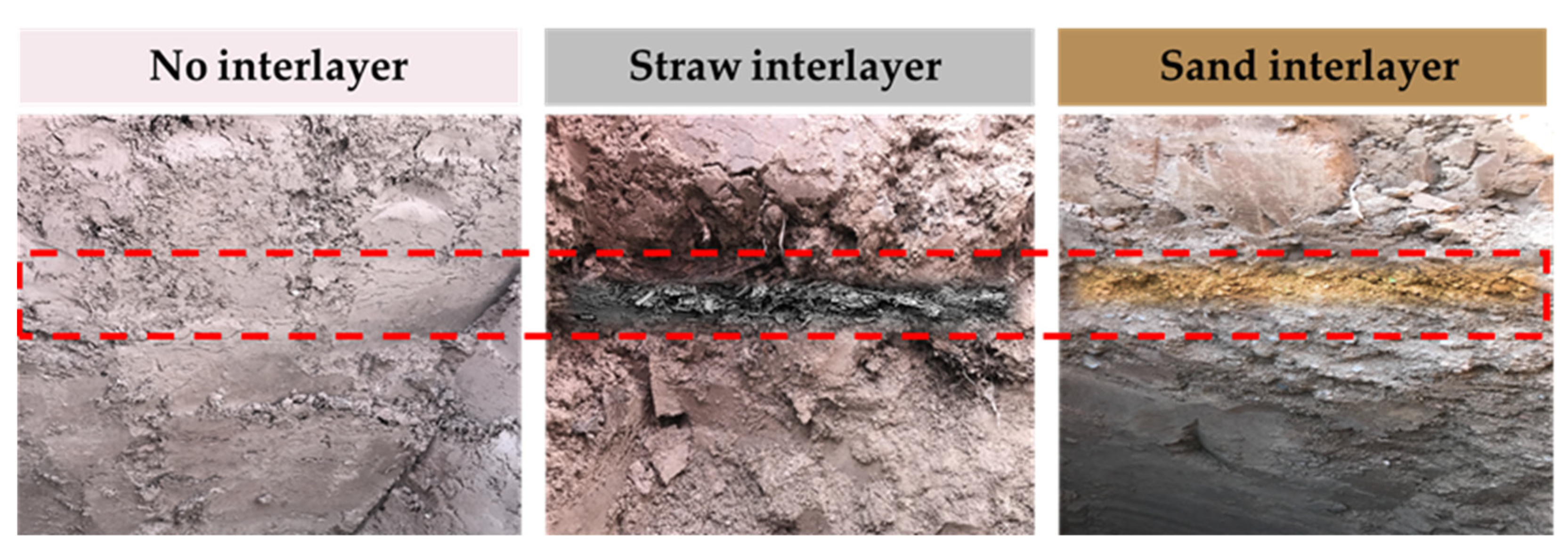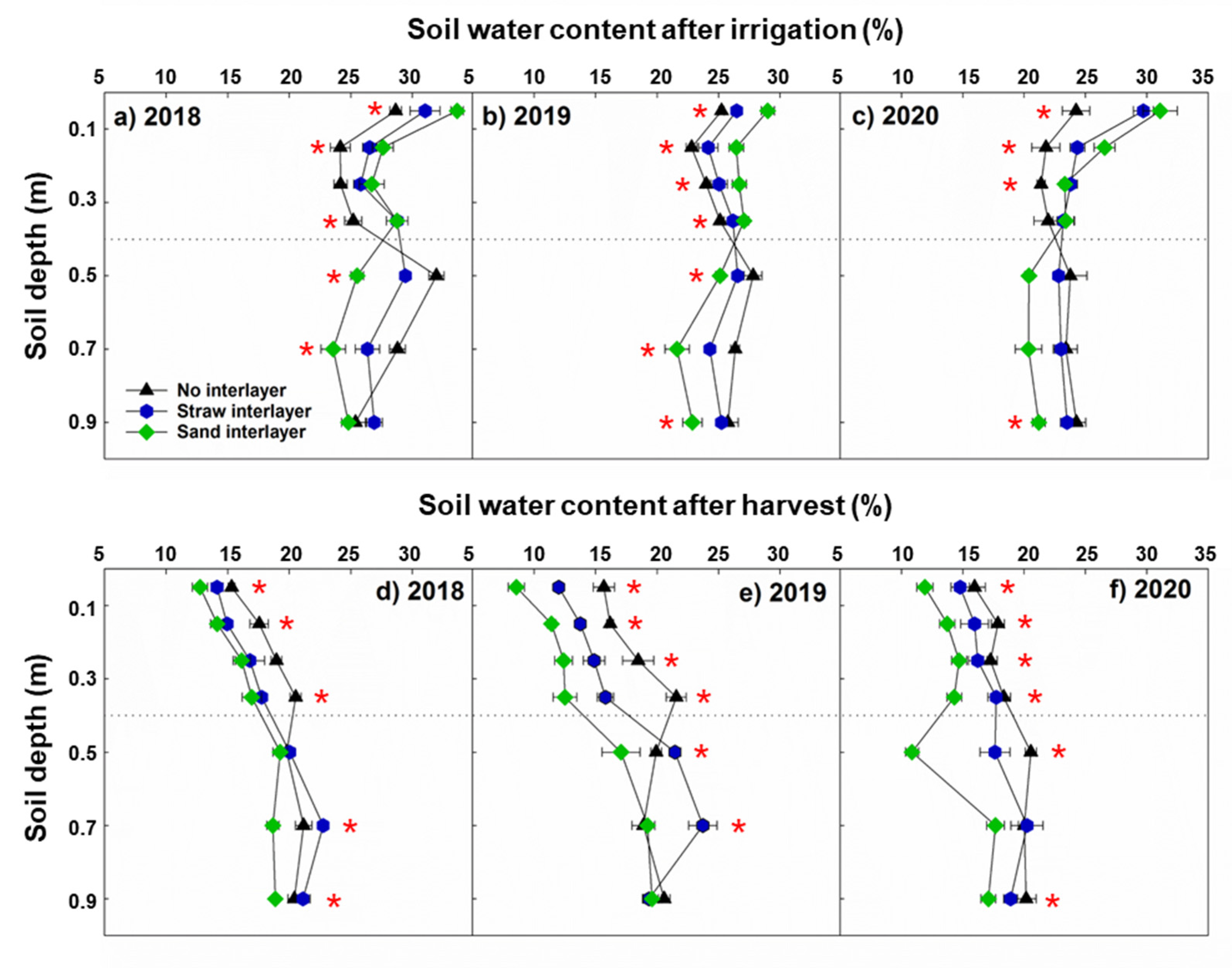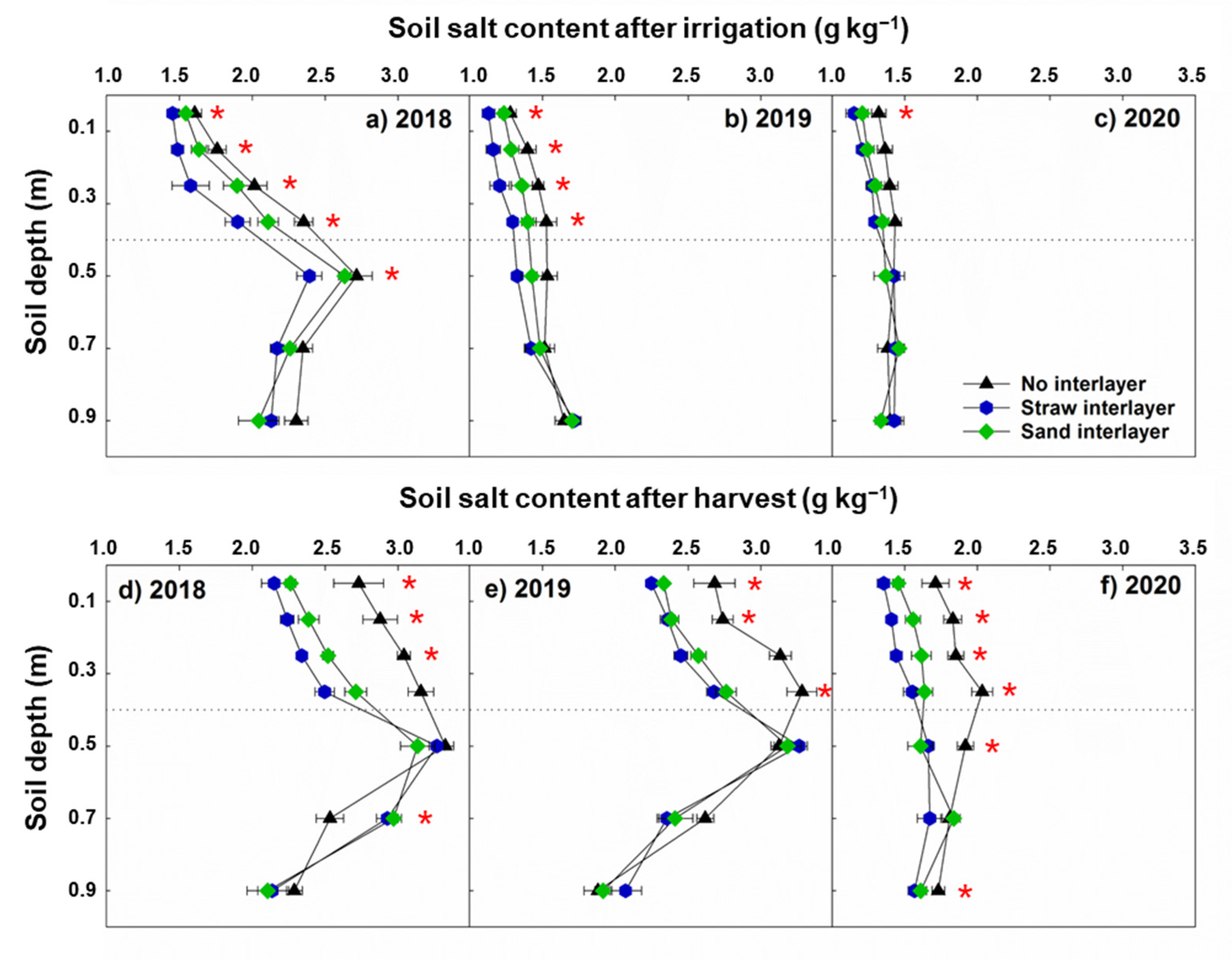If Sand Interlayer Acts Better than Straw Interlayer for Saline Soil Amelioration? A Three-Year Field Experiment
Abstract
:1. Introduction
2. Materials and Methods
2.1. Experimental Site
2.2. Experimental Design
2.3. Sampling and Measurement
2.4. Calculations
2.5. Data Analysis
3. Results
3.1. Both Sand Interlayer and Straw Interlayer Beneficially Altered the Distribution of Soil Water
3.2. Straw Interlayer Effectively Lowered the Accumulation of Salt in Upper Soil Layers of Soil
3.3. Straw Interlayer Treatment Showed the Best Stratification Ratio of Salt in Soil
3.4. Straw Interlayer Treatment Effectively Lowered the Soil Salt Flux
3.5. Water and Salt Distribution of Straw Interlayer-Mediated Improved the Sunflower Yield
4. Discussion
4.1. Different Interlayers Demonstrate Differential Effects on the Water in Soil
4.2. Different Interlayers Influence the Movement Profile of Salt in Soil
4.3. Interlayer Effectively Increased the Sunflower Yields
5. Conclusions
Supplementary Materials
Author Contributions
Funding
Acknowledgments
Conflicts of Interest
References
- Zhao, Y.T.; Wang, G.D.; Zhao, M.L.; Wang, M.; Jiang, M. Direct and indirect effects of soil salinization on soil seed banks in salinizing wetlands in the Songnen Plain, China. Sci. Total Environ. 2022, 819, 152035. [Google Scholar] [CrossRef] [PubMed]
- You, Y.M.; Chi, Y.W.; Chen, X.F.; Wang, J.C.; Wang, R.Y.; Li, R.T.; Chu, S.H.; Yang, X.J.; Zhang, D.; Zhou, P. A sustainable approach for bioremediation of secondary salinized soils: Studying remediation efficiency and soil nitrate transformation by bioaugmentation. Chemosphere 2022, 300, 134580. [Google Scholar] [CrossRef]
- Lu, C.; Pang, H.; Zhang, H.Y.; Zhang, J.L.; Zhang, H.; Li, Y.Y. Spring irrigation combined with straw interlayer promoting soil desalination and increasing microflora diversity. Trans. CSAE 2017, 33, 87–94. (In Chinese) [Google Scholar]
- Lei, T.W.; Issac, S.; Yuan, P.J.; Huang, X.F.; Yang, P.L. Strategic consideration of efficient irrigation and salinity control on Hetao Plain in Inner Mongolia. Trans. CSAE 2001, 17, 48–52. [Google Scholar]
- Zhang, H.Y.; Pang, H.C.; Zhao, Y.G.; Lu, C.; Liu, N.; Zhang, X.L.; Li, Y.Y. Water and salt exchange flux and mechanism in a dry saline soil amended with buried straw of varying thicknesses. Geoderma 2020, 365, 114213. [Google Scholar] [CrossRef]
- Zhao, Y.G.; Li, Y.Y.; Wang, J.; Pang, H.C.; Li, Y. Buried straw layer plus plastic mulching reduces soil salinity and increases sunflower yield in saline soils. Soil Tillage Res. 2016, 155, 363–370. [Google Scholar] [CrossRef]
- Cao, R.X.; Shao, M.A.; Jia, X.X. Experimental study on effects of layered soils on saturated hydraulic conductivity. J. Soil Water Conserv. 2015, 29, 18–21. (In Chinese) [Google Scholar]
- Qiao, J.B.; Liu, X.T.; Zhu, Y.J.; Jia, X.X.; Shao, M.A. Three-dimensional quantification of soil pore structure in wind-deposited loess under different vegetation types using industrial X-ray computed tomography. Catena 2021, 199, 105098. [Google Scholar] [CrossRef]
- Guo, G.; Araya, K.; Jia, H.; Zhang, Z.; Ohomiya, K.; Matsuda, J. Improvement of Salt-affected Soils, Part 1: Interception of Capillarity. Biosyst. Eng. 2006, 94, 139–150. [Google Scholar] [CrossRef]
- Luo, H.Y.; Yan, A.F.; Xie, J.H. Experimental investigation of upward movement of soil water in layered systems. Acta Pedol. Sin. 1965, 13, 313–324. (In Chinese) [Google Scholar]
- Li, Y.Z.; Hu, K.L. Simulation for the effect of clay layer on the transport of soil water and solutes under evaporation. Act Pedol. Sin. 2004, 41, 493–502. (In Chinese) [Google Scholar]
- Wang, X.T.; Hu, Z.Q.; Lai, X.J.; Liang, Y.S. Influence of clay interlayer position on infiltration of reclaimed soil filled with Yellow River sediment. Trans. CSAE 2019, 35, 86–93. (In Chinese) [Google Scholar]
- Shi, W.J.; Shen, B.; Wang, Z.R.; Zhang, J.F. Water and salt transport in sand-layered soil under evaporation with the shallow underground water table. Trans. CSAE 2005, 21, 23–26. (In Chinese) [Google Scholar]
- Cao, J.S.; Liu, C.M.; Zhang, W.J.; Guo, Y.L. Effect of integrating straw into agricultural soils on soil infiltration and evaporation. Water Sci. Technol. 2012, 65, 2213–2218. [Google Scholar] [CrossRef] [PubMed]
- Zhao, Y.G.; Pang, H.C.; Wang, J.; Huo, L.; Li, Y.Y. Effects of straw mulch and buried straw on soil moisture and salinity in relation to sunflower growth and yield. Field Crops Res. 2014, 161, 16–25. [Google Scholar] [CrossRef]
- Chen, S.; Mao, X.M.; Shang, S.H. Response and contribution of shallow groundwater to soil water/salt budget and crop growth in layered soils. Agric. Water Manag. 2022, 266, 107574. [Google Scholar] [CrossRef]
- Nur, A.; Huang, C.P. P-wave velocity and porosity of sand clay mixtures. World Well Logging Technol. 1992, 7, 72–81. (In Chinese) [Google Scholar]
- Bao, S.D. Soil and Agricultural Chemistry Analysis; Agriculture Press: Beijing, China, 2000. [Google Scholar]
- Pang, H.C.; Li, Y.Y.; Yang, J.S.; Liang, Y.S. Effect of brackish water irrigation and straw mulching on soil salinity and crop yields under monsoonal climatic condition. Agric. Water Manag. 2010, 97, 1971–1977. [Google Scholar] [CrossRef]
- Zhang, H.Y.; Lu, C.; Pang, H.C.; Liu, N.; Zhang, X.L.; Li, Y.Y. Straw interlayer burial to alleviate salt stress in silty loamsoils: Impacts of straw forms. J. Integr. Agric. 2018, 19, 265–276. [Google Scholar] [CrossRef]
- Benson, C.H.; Albright, W.H.; Roesler, A.C.; Abichou, T. Evaluation of final cover performance, field data from the Alternative Cover Assessment Program (ACAP). In Proceedings of the WM 2002 Conference, Tucson, AZ, USA, 24–28 February 2002; pp. 1–7. [Google Scholar]
- Yang, H.; Rahardjo, H.; Leong, E.-C. Behavior of Unsaturated Layered Soil Columns during Infiltration. J. Hydrol. Eng. 2006, 11, 329–337. [Google Scholar] [CrossRef] [Green Version]
- Yan, C.-g.; Wan, Q.; Xu, Y.; Xie, Y.; Yin, P. Experimental study of barrier effect on moisture movement and mechanical behaviors of loess soil. Eng. Geol. 2018, 240, 1–9. [Google Scholar] [CrossRef]
- Zhang, H.Y.; Pang, H.C.; Lu, C.; Liu, N.; Zhang, X.L.; Li, Y.Y. Pore characteristics of straw interlayer based on computed tomography images and its influence on soil water infiltration. Trans. CSAE 2019, 35, 114–121. (In Chinese) [Google Scholar]
- Wang, X.Q.; Zhang, H.Y.; Zhang, Z.Z.; Zhang, C.P.; Zhang, K.; Pang, H.C.; Bell, S.M.; Li, Y.Y.; Chen, J. Reinforced soil salinization with distance along the river: A case study of the Yellow River Basin. Agric. Water Manag. 2023, 279, 108184. [Google Scholar] [CrossRef]
- Koutroubas, S.D.; Antoniadis, V.; Damalas, C.A.; Fotiadis, S. Sunflower growth and yield response to sewage sludge application under contrasting water availability conditions. Ind. Crops Prod. 2020, 154, 112670. [Google Scholar] [CrossRef]
- García-López, J.; Lorite, I.J.; García-Ruiz, R.; Domínguez, J. Evaluation of three simulation approaches for assessing yield of rainfed sunflower in a Mediterranean environment for climate change impact modelling. Clim. Change 2014, 124, 147–162. [Google Scholar] [CrossRef]
- Sorkheh, K.; Shiran, B.; Rouhi, V.; Khodambashi, M.; Wolukau, J.N.; Ercisli, S. Response of in vitro pollen germination and pollen tube growth of almond (Prunus dulcis Mill.) to temperature, polyamines, and polyamine synthesis inhibitor. Biochem. Syst. Ecol. 2011, 39, 749–757. [Google Scholar] [CrossRef]
- Huo, L.; Pang, H.C.; Zhao, Y.G.; Wang, J.; Lu, C.; Li, Y.Y. Buried straw layer plus plastic mulching improves soil organic carbon fractions in an arid saline soil from Northwest China. Soil Tillage Res. 2017, 165, 286–293. [Google Scholar] [CrossRef]




| Soil Depth (m) | BD (g cm−3) | SOC (g kg−1) | TN (g kg−1) | AN (mg kg−1) | AP (mg kg−1) | AK (mg kg−1) | TS (g kg−1) | pH |
|---|---|---|---|---|---|---|---|---|
| 0–0.20 | 1.45 | 6.50 | 0.88 | 35.50 | 6.25 | 168.17 | 6.78 | 8.68 |
| 0.20–0.40 | 1.50 | 5.20 | 0.71 | 33.25 | 4.40 | 126.83 | 4.59 | 8.36 |
| 0.40–0.60 | 1.48 | 3.31 | 0.56 | 29.5 | 3.04 | 109.24 | 3.23 | 8.32 |
| Index | Year | Interlayer | ||
|---|---|---|---|---|
| No | Straw | Sand | ||
| SDR (%) | 2018 | 65.56 ± 0.61 b | 71.41 ± 0.82 a | 68.00 ± 1.03 b |
| 2019 | 66.39 ± 1.11 a | 64.63 ± 1.13 a | 64.16 ± 0.97 a | |
| 2020 | — | — | — | |
| SRR (%) | 2018 | 52.62 ± 2.57 a | 43.91 ± 2.18 b | 37.68 ± 2.42 b |
| 2019 | 108.71 ± 7.69 a | 103.13 ± 5.05 a | 90.61 ± 6.27 a | |
| 2020 | 35.04 ± 6.12 a | 16.88 ± 1.16 b | 23.01 ± 2.46 ab | |
| Time | Year | Stratification Ratio (%) | ||
|---|---|---|---|---|
| No | Straw | Sand | ||
| Before irrigation | 2018 | 1.31 ± 0.007 a | 1.31 ± 0.007 a | 1.31 ± 0.007 a |
| 2019 | 1.60 ± 0.051 a | 1.23 ± 0.025 b | 1.32 ± 0.020 b | |
| 2020 | — | — | — | |
| After irrigation | 2018 | 0.79 ± 0.010 a | 0.72 ± 0.013 a | 0.78 ± 0.030 a |
| 2019 | 0.91 ± 0.025 a | 0.81 ± 0.014 a | 0.86 ± 0.048 a | |
| 2020 | 0.98 ± 0.036 a | 0.86 ± 0.027 b | 0.93 ± 0.015 ab | |
| After harvesting | 2018 | 1.09 ± 0.044 a | 0.83 ± 0.012 b | 0.90 ± 0.026 b |
| 2019 | 1.17 ± 0.035 a | 0.95 ± 0.023 b | 1.00 ± 0.004 b | |
| 2020 | 1.02 ± 0.021 a | 0.88 ± 0.018 b | 0.95 ± 0.031 ab | |
| Index | Year | Interlayer | ||
|---|---|---|---|---|
| No | Straw | Sand | ||
| FL (g m−2 d−1) | 2018 | 340.72 ± 4.97 b | 379.22 ± 3.99 a | 358.80 ± 6.49 b |
| 2019 | 226.67 ± 8.49 a | 169.47 ± 5.68 b | 185.41 ± 4.48 b | |
| 2020 | — | — | — | |
| FE (g m−2 d−1) | 2018 | 22.67 ± 1.31 a | 15.02 ± 1.40 b | 14.62 ± 1.47 b |
| 2019 | 32.63 ± 1.87 a | 25.07 ± 0.81 b | 24.60 ± 1.25 b | |
| 2020 | 10.61 ± 1.57 a | 4.42 ± 0.39 b | 6.30 ± 0.60 b | |
| Index | Year | Interlayer | ||
|---|---|---|---|---|
| No | Straw | Sand | ||
| Emergence rate (%) | 2018 | 74.15 ± 3.11 b | 84.20 ± 1.63 a | 85.12 ± 2.90 a |
| 2019 | 78.82 ± 1.00 b | 87.09 ± 2.90 ab | 88.69 ± 2.85 a | |
| 2020 | — | — | — | |
| Seed yields (t ha−1) | 2018 | 2.81 ± 0.10 b | 3.33 ± 0.04 a | 2.92 ± 0.07 b |
| 2019 | 3.85 ± 0.07 b | 4.27 ± 0.08 a | 3.48 ± 0.10 c | |
| 2020 | 3.55 ± 0.06 b | 4.17 ± 0.05 a | 3.71 ± 0.06 b | |
Disclaimer/Publisher’s Note: The statements, opinions and data contained in all publications are solely those of the individual author(s) and contributor(s) and not of MDPI and/or the editor(s). MDPI and/or the editor(s) disclaim responsibility for any injury to people or property resulting from any ideas, methods, instructions or products referred to in the content. |
© 2023 by the authors. Licensee MDPI, Basel, Switzerland. This article is an open access article distributed under the terms and conditions of the Creative Commons Attribution (CC BY) license (https://creativecommons.org/licenses/by/4.0/).
Share and Cite
Liu, N.; Feng, W.; Zhang, H.; Chang, F.; Wang, J.; Li, Y.; Pang, H. If Sand Interlayer Acts Better than Straw Interlayer for Saline Soil Amelioration? A Three-Year Field Experiment. Sustainability 2023, 15, 4931. https://doi.org/10.3390/su15064931
Liu N, Feng W, Zhang H, Chang F, Wang J, Li Y, Pang H. If Sand Interlayer Acts Better than Straw Interlayer for Saline Soil Amelioration? A Three-Year Field Experiment. Sustainability. 2023; 15(6):4931. https://doi.org/10.3390/su15064931
Chicago/Turabian StyleLiu, Na, Wenhao Feng, Hongyuan Zhang, Fangdi Chang, Jing Wang, Yuyi Li, and Huancheng Pang. 2023. "If Sand Interlayer Acts Better than Straw Interlayer for Saline Soil Amelioration? A Three-Year Field Experiment" Sustainability 15, no. 6: 4931. https://doi.org/10.3390/su15064931
APA StyleLiu, N., Feng, W., Zhang, H., Chang, F., Wang, J., Li, Y., & Pang, H. (2023). If Sand Interlayer Acts Better than Straw Interlayer for Saline Soil Amelioration? A Three-Year Field Experiment. Sustainability, 15(6), 4931. https://doi.org/10.3390/su15064931






